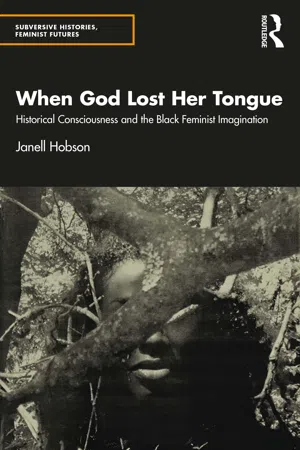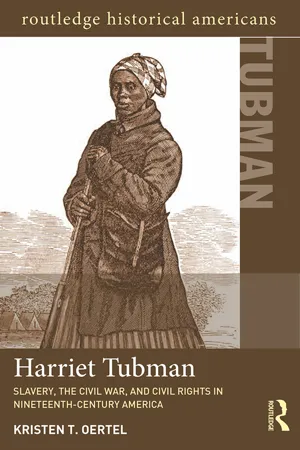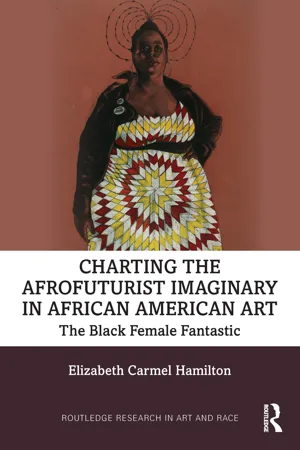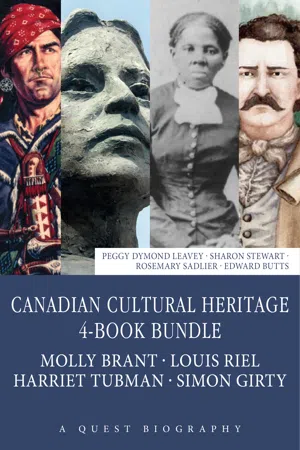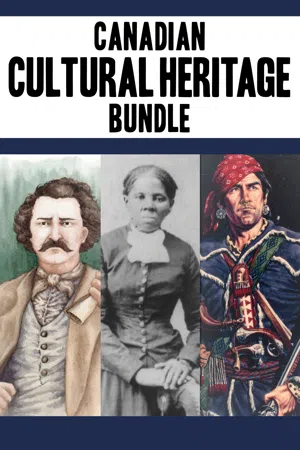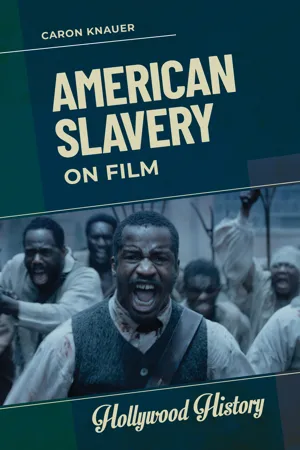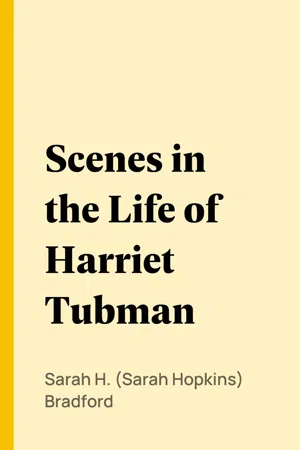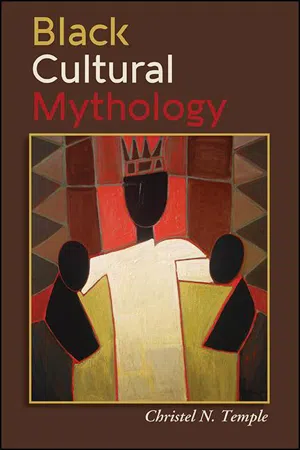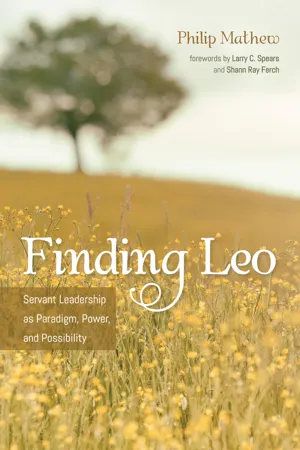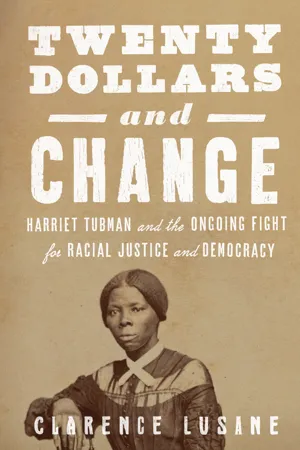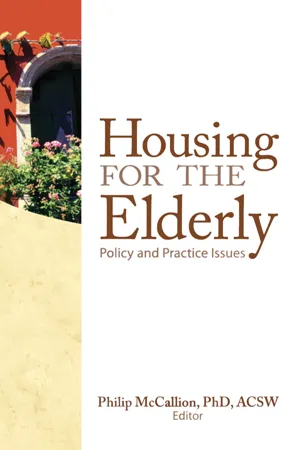History
Harriet Tubman
Harriet Tubman was an African American abolitionist and political activist who played a pivotal role in the Underground Railroad, a network of safe houses and routes that helped enslaved people escape to freedom. She also served as a spy and scout for the Union Army during the American Civil War. Tubman's courageous efforts to fight against slavery and advocate for civil rights have left a lasting impact on American history.
Written by Perlego with AI-assistance
Related key terms
11 Key excerpts on "Harriet Tubman"
- eBook - ePub
When God Lost Her Tongue
Historical Consciousness and the Black Feminist Imagination
- Janell Hobson(Author)
- 2021(Publication Date)
- Routledge(Publisher)
4Cultural currency and the value of Harriet Tubman
DOI: 10.4324/9780429243554-6They wouldn’t give a sixpence for me. – Harriet TubmanHarriet Tubman’s name resonates in American culture. Celebrated for her status as a self-emancipated woman who guided others to freedom, the incomparable Tubman would become the most famous of the “conductors” on the Underground Railroad in the antebellum U.S. Since their time in this country, enslaved African Americans routinely made escapes from slavery; however, it was not until the 1830s that abolitionists formalized the Underground Railroad as a secret network aiding those who wished to escape their “chattel” status, a history well documented by the network’s most renowned “station master,” William Still.1As an antislavery activist community, which included both Black and White allies – enslaved and free – Underground Railroad secret operatives hid freedom seekers in their homes or churches, transported them on wagons or boats, and spread secret communication codes through letters and word-of-mouth. The most skilled of these navigators worked as guides, or “conductors,” for those seeking freedom in northern states and across the border in Canada – the latter an eventual destination once the U.S. Congress passed the 1850 Fugitive Slave Law that legitimized the recapture of those who had escaped from slavery. While freedom seekers in other regions of the country used different escape routes and other means to resist slavery,2 Tubman carried out much of her heroic work along the Eastern Shore.The skills that Tubman honed as an Underground Railroad conductor shaped her later work as a Union Army nurse, spy, and scout during the U.S. Civil War. She also became the first woman in U.S. history to lead a military raid that ultimately freed nearly 800 slaves. Through all these accomplishments, Tubman earned her reputation as “Moses,” as nicknamed by William Lloyd Garrison, editor of the abolitionist newspaper The Liberator. - eBook - ePub
Harriet Tubman
Slavery, the Civil War, and Civil Rights in the 19th Century
- Kristen T. Oertel(Author)
- 2015(Publication Date)
- Routledge(Publisher)
29 America’s tragic flaws must be paired with its triumphs because much of American identity is embedded in that central tension between the ideals of democracy and the practice of oppression; furthermore, American students need to see the human in history. A litany of heroic acts and larger-than-life historical figures places the past on a pedestal, making it more difficult for students to connect with history and learn from it.Thus Harriet Tubman’s courageous feats on the Underground Railroad and her accomplishments while serving in the Union army must be discussed alongside the unfortunate truths of black and female inequality in order to absorb the full breadth of her life and its challenges. Tubman, like many African Americans living in the nineteenth century, struggled with poverty, racism, and sexism throughout her lifetime and died nearly penniless. The fact that one of the most well-known black women in the United States repeatedly found herself in dire living conditions attests to the larger structural inequalities that wove their way into American society. If we only focus on the hero, on the Tubman who stands above the crowd and “beats” the slave catchers, we forget a much larger part of the story, the injustices that persistently weighed Tubman down before and after her storied career on the UGRR.And yet, the Tubman myth prevails in American culture, even as more complicated portraits of her show up on library shelves and in college classrooms. The proliferation of children’s books that focus on Tubman continues, but the more recent texts take into account the centrality of slavery in American history and offer a surprisingly honest account of its brutality. For example, Harriet Tubman, Secret Agent , published by National Geographic in 2006, opens with a bold and unadulterated vision of the institution: “Long before the Civil War began, Harriet Tubman started her own war against slavery. Born a slave, she worked day after day and year after year on Maryland farms. The daughter of one master whipped her, scarring her for life. Another master fractured her skull. She saw her sisters taken away by slave traders.” Author Thomas B. Allen expanded the typical chronology presented in many children’s books and highlights Tubman’s service in the Union army. In fact, the subtitle of the book, How Daring Slaves and Free Blacks Spied for the Union During the Civil War , reveals this focus, and Allen provides a cast of characters that includes lesser-known abolitionists like Alexander Milton Ross and other female spies like Elizabeth Van Lew. He acknowledges that Tubman worked inside a network of free blacks and slaves, claiming, “She was not alone. She was one of countless—and usually unknown—African-Americans who served the Union as spies.” 30 - eBook - ePub
Charting the Afrofuturist Imaginary in African American Art
The Black Female Fantastic
- Elizabeth Carmel Hamilton(Author)
- 2022(Publication Date)
- Routledge(Publisher)
1 In typical science fiction narratives, writers ideologically hold African Americans in the past, so positing a future is a revolutionary act. Using a historical figure adds depth to the posited future. That is, artists demonstrating an awareness of the past while engaging in the future is crucial to African American survival.The year 1913, the semicentennial of the Emancipation Proclamation, also saw the death of one of the most memorable figures of the antebellum era: Harriet Tubman. According to local newspapers, nearly one thousand mourners gathered in Auburn, New York, to pay their last respects to the former Civil War scout and nurse, Underground Railroad conductor, and humanitarian.2 Tubman's multiple journeys south to rescue family members and others from slavery, following her own escape, made her a Moses figure in popular memory. Her journeys into dangerous territory and her unselfish prioritization of the people she went to save, transformed her into a figurative symbol of bravery.Today, over a century after her death, Tubman is still an icon remembered for repeatedly striking out into the unknown in an attempt to create a new world for herself and others and represents the movement of seemingly impossible barriers of time and space in enslavement to arrive at a symbolic Promised Land. Rather than using her image to commemorate the past, artists in the twenty-first century deploy Tubman as a dynamic symbol of the future. While artistic representations of and allusions to Harriet Tubman can commemorate the nineteenth-century American slave past, they are also potential spaces for imparting Tubman as an Afrofuturistic symbol in twentieth- and twenty-first-century art. Octavia Butler, Erykah Badu, Alison Saar, Pierre Bennu, Sanford Biggers, and Janelle Monáe project Tubman's legacy into the future in ways that not only oppose slavery and oppression but also identify methods of survival and examples of resilience. As a result, they challenge the notion of a post-racial American society that attempts to undermine contemporary civil rights agendas. - eBook - ePub
Canadian Cultural Heritage 4-Book Bundle
Molly Brant / Louis Riel / Harriet Tubman / Simon Girty
- Peggy Dymond Leavey, Sharon Stewart, Rosemary Sadlier, Edward Butts(Authors)
- 2015(Publication Date)
- Dundurn Press(Publisher)
Through my mother’s family, I am a descendant of those who made their way to Canada through their contact with the Underground Railroad. Because of this I am particularly interested in the courage of these freedom seekers and am fascinated by the ways in which they came to be free. Unfortunately, I am deeply aware of how little information is known or made available about the systems they used. Despite the importance of this heritage being passed down through the generations to contemporary black and wider community members, particularly through oral tradition, many personal experiences of freedom seekers remain hidden forever. Due to the historic nature of many of the quotations in this book, they may contain archaic and unconventional spellings. The publisher has chosen to lowercase “black.”Harriet Tubman was committed to helping her family and this prompted her to carry out several crossings to rescue her relatives. I wondered if perhaps within the fabric of the stories of the Tubman family there would be details that would extend our knowledge of Harriet and the secret routes she used? Or if perhaps her legacy had lived on through the presence of her descendants? Because the descendants might hold the answer to some of the missing pieces, I began a study of Tubman’s family legacy, as well as her own historical legacy. I met with many descendants from both the United States and Canada and I have included a section on Harriet’s North American genealogy, reflecting her family in both the United States and Canada.I feel that information about her family is important to our understanding of Tubman, the Underground Railroad, and the settlement of people of African descent. It is important for those who have made the run for freedom and never arrived, for those buried in forgotten or hidden cemeteries without our knowledge, and for those of us, like Harriet, who realize that one person can make a difference.Passage contains an image
Introduction
IntroductionThis book will provide some new interpretations and information on the most notable African-American/African-Canadian conductor on the legendary Underground Railroad: Harriet Tubman. Based upon interviews with Tubman descendants, archival materials, and extant literature, this book will acquaint the reader with the experience and contribution of just one of the many notable, identified leaders on the Underground Railroad, placing her in a local, regional, international, and global context.The Underground Railroad was the first freedom movement of the Americas and is credited with infusing Canada with a number of black people. How did it work? Where did people come into Canada? How were they treated upon their arrival? How is it that we spoke of these things in certain places and why was this missing from the education that I was receiving at school? - eBook - ePub
Canadian Cultural Heritage Bundle
Louis Riel / Harriet Tubman / Simon Girty
- Sharon Stewart, Edward Butts, Rosemary Sadlier(Authors)
- 2013(Publication Date)
- Dundurn Press(Publisher)
Harriet Tubman
Passage contains an image
Introduction
This book will provide some new interpretations and information on the most notable African-American/African-Canadian conductor on the legendary Underground Railroad: Harriet Tubman. Based upon interviews with Tubman descendants, archival materials, and extant literature, this book will acquaint the reader with the experience and contribution of just one of the many notable, identified leaders on the Underground Railroad, placing her in a local, regional, international, and global context.The Underground Railroad was the first freedom movement of the Americas and is credited with infusing Canada with a number of black people. How did it work? Where did people come into Canada? How were they treated upon their arrival? How is it that we spoke of these things in certain places and why was this missing from the education that I was receiving at school?The nature of slavery did not lend itself for many to keep detailed records. For slave owners, the date and place of the birth of the offspring of enslaved women was not always recorded and was left to memory. Many now feel that ancestral memory has power; that “indigenous knowledge” has value not always accepted or recognized. However, the selling of slaves had an impact on plantation memory. No one may have remained in your circle who could verify your date of birth, or even your parentage. No one may have realized the need to do so. When an enslaved African was sold, and once that memory was gone, it was as if a library had been lost. The stories about your birth, issues on your plantation, would be lost unless there had been an opportunity for this information to be passed down through African oral tradition or recorded by slave owners.To this end, there are several dates for Harriet Tubman’s birth in the literature. A descendant fervently believed Tubman to have been born in 1820, “if not earlier.” Harriet Tubman herself indicated that she was “about seventy-five years old” in 1898 as she was trying to ensure that she receive her back pay for her military service and status as a widow. Was she being modest about her age, or is it that she did not know her exact age and took her best guess? Another famous black abolitionist, Frederick Douglass, took February 14th to be his birth date as he had never been provided with documentation to indicate otherwise. - eBook - ePub
- Caron Knauer(Author)
- 2023(Publication Date)
- ABC-CLIO(Publisher)
Tubman: The Moses of Her People. She said Harriet was greater than Joan of Arc; Grace Darling, a Victorian lighthouse keeper’s daughter who rescued a shipwreck’s survivors; and the legendary nurse, hospital, and health care visionary Florence Nightingale, for “not one of these women, noble and grave as they were, showed more courage, and power of endurance, in facing danger and death than the woman known to posterity as Harriet Tubman, ‘the Moses of her people’” (Bradford, quoted by Sernett 2007).William Lloyd Garrison, the abolitionist and editor of the Liberator, gave Tubman the name Moses as he led the enslaved Hebrews out of Egypt. He, like Tubman, was a spiritual and political visionary who also “understood the lines between peoples and places and how to traverse them to shield himself and his followers from harsh enemy subjection and slavery. . . . [E]ach in essence transcended location and nationality to provide greater freedom and to sidestep persecution for a comparative ‘Promised Land’” (Broyld 2014, 87).Tubman met John Andrew, the former governor of Massachusetts, in 1862. An abolitionist and former lawyer who offered his legal services to John Brown following his raid on Harpers Ferry, Andrew was aware of her exploits and asked Tubman to join the Union Army after President Lincoln ended slavery with the Emancipation Proclamation in January 1863. Andrew asked her to go to Hilton Head, South Carolina—an area the Union acquired at the beginning of the war—to help fight against the Confederacy. He deduced she would make a great spy; Tubman’s “intimate knowledge of the marshlands on the Eastern Shore of Maryland would come in handy for the Union officers stationed on the swampy shores of South Carolina” (Dunbar 2019, 84).Tubman opened a “wash house” for soldiers, doing laundry while teaching women how to be laundresses and entrepreneurial. She helped nurse the sick and dying in Beaufort, South Carolina, where “more men were dying of diseases like yellow fever and cholera than bullets” (Dunbar 2019, 88). There weren’t many medicinal substances available at the time, and Tubman was lauded during the Civil War for being so knowledgeable about and adept at mixing healing roots, herbs, and botanicals (Dunbar 2019, 88). She knew, for example, that the paregoric she had given to quiet babies and suppress coughing and appetites when escaping was also an antidote for dysentery. - eBook - ePub
- Sarah H. (Sarah Hopkins) Bradford(Author)
- 2018(Publication Date)
- Perlego(Publisher)
I have wrought in the day—you in the night. I have had the applause of the crowd and the satisfaction that comes of being approved by the multitude, while the most that you have done has been witnessed by a few trembling, scared, and foot-sore bondmen and women, whom you have led out of the house of bondage, and whose heartfelt " God bless you " has been your only reward. The midnight sky and the silent stars have been the witnesses of your devotion to freedom and of your heroism. Excepting John Brown—of sacred memory—I know of no one who has willingly encountered more perils and hardships to serve our enslaved people than you have. Much that you have done would seem improbable to those who do not know you as I know you. It is to me a great pleasure and a great privilege to bear testimony to your character and your works, and to say to those to whom you may come, that I regard you in every way truthful and trustworthy. Your friend, Frederick Douglass. SOME SCENES IN THE LIFE OF Harriet Tubman. Harriet Tubman, known at various times, and in various places, by many different names, such as "Moses," in allusion to her being the leader and guide to so many of her people in their exodus from the Land of Bondage; "the Conductor of the Underground Railroad;" and "Moll Pitcher," for the energy and daring by which she delivered a fugitive slave who was about to be dragged back to the South; was for the first twenty-five years of her life a slave on the eastern shore of Maryland. Her own master she represents as never unnecessarily cruel; but as was common among slaveholders, he often hired out his slaves to others, some of whom proved to be tyrannical and brutal to the utmost limit of their power. She had worked only as a field-hand for many years, following the oxen, loading and unloading wood, and carrying heavy burdens, by which her naturally remarkable power of muscle was so developed that her feats of strength often called forth the wonder of strong laboring men - eBook - ePub
- Christel N. Temple(Author)
- 2020(Publication Date)
- SUNY Press(Publisher)
Chapter Three Harriet Tubman and Aesthetic Memorialization Chapter 1 established Harriet Tubman’s role as a stable African American mythoform of great symbolic value to the intellectual tradition, setting the stage for this chapter’s more sustained analysis of her centrality to Black cultural mythology. Molefi Kete Asante addresses Tubman’s iconography and the primacy of history in his articulation of heroics of memory: “We are creatures of our history, and the brilliance of any liberation paradigm must be found in that history. When we know, truly know … that Tubman was a socialist and a revolutionary nationalist … we can analyze contemporary situations more accurately. … Our history is one of struggle and victory; this knowledge is necessary as we attempt to reconstruct and mobilize.” 1 Black cultural mythology is such a philosophical reconstruction, and Asante’s model of revitalizing the legacy of Harriet Tubman by defining her as more than a static textbook heroine is a vital interpretive shift. Tubman is one of the most recognized survivors of enslavement, and society has responded to the depths of her cognitive survival, epic intuitive conduct, and hyperheroic impulses with a stable level of respect and honor that culminated in 2017 with the announcement that Tubman’s image will replace Andrew Jackson’s face on one side of the next iteration of the US twenty-dollar bill. The images on US currency have been a longtime reminder of power, privilege, and normalized assumptions about who is universally important in American history, yet the groundbreaking transition to having a woman of African descent on the currency does not sequester discourse about Tubman’s centrality to Black cultural mythology. The decision to place Tubman’s image on the twenty-dollar bill, which will take effect in a matter of years, brings much satisfaction to progressives and liberals who view the replacement as an acknowledgment of the nation’s diversity - eBook - ePub
Finding Leo
Servant Leadership as Paradigm, Power, and Possibility
- Philip Mathew(Author)
- 2021(Publication Date)
- Wipf and Stock(Publisher)
93By 1860 , Tubman had traveled the Underground Railroad at least nineteen different times. She was proud that she never veered off track or lost a passenger.94 Frederick Douglass recognized Tubman’s heroic efforts, “Excepting John Brown—of sacred memory—I know of no one who has willingly encountered more perils and hardships to serve our enslaved people than [Harriet Tubman].”95Tubman’s servant-leadership extended well beyond leading the enslaved to freedom. As part of her work as an abolitionist, she provided food, medical care, and clothing for the rescued. She joined the war effort, serving as a nurse and soldier in the Union Army, becoming the first woman to carry out a military operation.96 Tubman was asked by the federal government to assist Black soldiers in Massachusetts by organizing medical care and dignified burials. During this critical period in the nation’s history, Tubman served as an advocate for African-American soldiers. She was instrumental in drawing attention to the deplorable conditions they faced in the wake of their service to the nation. After the war, Tubman moved to Auburn, New York where she established a residential care home. She served there until her death in 1913 .As a conductor in the Underground Railroad, Tubman was the ultimate servant-leader. Much like Leo in Hesse’s novel, Tubman guided her passengers to freedom through selfless service. She lifted their morale and served as the glue that held each group together along their journey to freedom. Tubman was well acquainted with the brutality of bondage. Despite the potential costs, she willingly risked her own freedom on behalf of others. She had skin in the game. Greenleaf explained that a servant-leader is a servant first— - eBook - ePub
Twenty Dollars and Change
Harriet Tubman and the Ongoing Fight for Racial Justice and Democracy
- Clarence Lusane(Author)
- 2022(Publication Date)
- City Lights Publishers(Publisher)
“There was a glory over everything. The sun came like gold through the trees, and over the fields, and I felt like I was in heaven.” —Harriet Tubman, describing the moment she achieved self-emancipation“Excepting John Brown—of sacred memory—I know of no one who has willingly encountered more hardships to serve our enslaved people than you have. Much that you have done would seem improbable to those who do not know you as I know you. It is to me a great pleasure and a great privilege to bear testimony for your character and your works, and to say to those to whom you may come, that I regard you in every way truthful and trustworthy.”—Frederick Douglass, from his August 29, 1868, letter to Harriet TubmanHarriet Tubman escaped to freedom in the late fall of 1849, resistance to slavery was intense on multiple fronts.75 First and foremost were the black people who fought to disrupt and sabotage the daily life of their white enslavers in every possible way. The trope of the “happy slave” was a myth that belied the hellish conditions black people endured in the antebellum South. Like Tubman, thousands of enslaved black people took the perilous risk of self-emancipating by escaping to the north. In 1849, Tubman was one of at least 278 people who escaped from Maryland.76BY THE TIMEResistance to the slaveocracy of the South took many forms, including the emergence of Maroon communities—areas of liberation occupied by escaped individuals that often included Native Americans. Scores of these societies existed in the South and other parts of the country during the slavery era and after.77 - eBook - ePub
Housing for the Elderly
Policy and Practice Issues
- Philip McCallion, Philip McCallion(Authors)
- 2013(Publication Date)
- Routledge(Publisher)
During the early 1850s, Harriet Tubman began her work with the Underground Railroad, reportedly rescuing over 300 enslaved people (Benge & Benge, 2002 ; Clinton, 2004a ; Humez, 2003 ; Janney, 1999 ; Petry, 1955). Family members were among the enslaved persons that she navigated to freedom using the “North Star” (Bradford, 1886, p. 17; 6 and 7, p. 34; and Humez, 2003, p. 218). This illiterate yet visionary champion of freedom used her faith and wit to work toward an end to the cruel institution of slavery. Although Canada was her base during the Underground Railroad years, she later resettled in Auburn, New York, a major station of the Underground Railroad. In 1857, William Seward, Governor of New York and avid supporter of Tubman, presented her with the deed to a house in Auburn. To avoid any appearance of charity, she asked to make a small regular series of payments. She later paid off the mortgage from the $1,400 in proceeds from the sale of a book about her life “Scenes in the Life of Harriet Tubman” written by Sarah Bradford in 1869. One of Harriet Tubman’s most remarkable accomplishments was escorting her aged parents to freedom. Ironically, some historians recorded this as one of the low points in her profile of courage–the uprooting of elders. While no justification is needed for wanting her aging parents to experience freedom, there was a compelling circumstance for her decision to rescue her parents. Shortly after moving to her home in Auburn, Harriet Tubman was notified that her father, now in his seventies, was awaiting trial for helping a fellow enslaved African. In response, in 1857, at the age of 37, Harriet engineered the escape of her mother and father who were both elderly. This escape is described as “a model of simplicity–and extraordinary daring” (Taylor, 1991, p. 69), with Tubman boldly driving her aged parents out of the south in the openness of a horse-drawn wagon. As cited by Taylor (p
Index pages curate the most relevant extracts from our library of academic textbooks. They’ve been created using an in-house natural language model (NLM), each adding context and meaning to key research topics.
